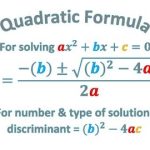7
Shannon Sprute
Math is one of those subjects that every student seems to struggle with at one point or another. Mathematics leaves very little room for error, it’s either right or wrong, and this can be extremely frustrating for students. So, what can we as educators do to make math more relatable, help students with understanding, and ditch the stigma that math is “boring”?
Learning styles have been the go-to solution for student engagement in the classroom. Students are classified into groups by their “learning style”, and lessons are framed around these styles. Students are encouraged to learn and engage with their particular style of learning. Unfortunately, these learning styles can hold students back from their full learning potential. As educators, to reach full embodiment in our classrooms we need to ditch the learning styles and focus on teaching our students through full embodiment. There are many strategies and techniques that can be applied to the classroom for educators to move away from standard learning styles and work towards a classroom of embodiment. To achieve embodiment within the classroom it is essential to understand how the brain functions. Having a grasp on how the brain functions, and a basic overview of cognition can help ensure that we take the right steps in fully educating our students.
 The cerebral cortex (the outer portion of our brain) is split up into two hemispheres; the left and the right. Each hemisphere can be split into four lobes. These lobes consist of the frontal lobe, parietal lobe, occipital lobe, and temporal lobe. These four lobes each have a specialized function in memories and thoughts. The frontal lobe is responsible for self-regulation, planning, reasoning, and problem-solving. The parietal lobe (behind the frontal) is responsible for sensory information like touching, or pain. The temporal lobe is where sensory information is processed. This lobe is important for hearing, understanding, and making memories. The occipital lobe is where we do our visual processing. The occipital lobe helps us understand what we are seeing. Although each part of the brain has its primary function, the different parts often rely on each other.
The cerebral cortex (the outer portion of our brain) is split up into two hemispheres; the left and the right. Each hemisphere can be split into four lobes. These lobes consist of the frontal lobe, parietal lobe, occipital lobe, and temporal lobe. These four lobes each have a specialized function in memories and thoughts. The frontal lobe is responsible for self-regulation, planning, reasoning, and problem-solving. The parietal lobe (behind the frontal) is responsible for sensory information like touching, or pain. The temporal lobe is where sensory information is processed. This lobe is important for hearing, understanding, and making memories. The occipital lobe is where we do our visual processing. The occipital lobe helps us understand what we are seeing. Although each part of the brain has its primary function, the different parts often rely on each other.
As we encounter different situations in our environment our brain actively works to store it or dismiss it. Throughout the brain, there are cells that activate to support our behavior. When these cells activate they sync up and create a network. Neurons get activated and fire up another neuron which fires up another neuron and so on. These firing of neurons create a pattern in our brains that help us better predict future situations. As neurons fire together they become stronger which helps aid in making memories. To store a memory we must first encode it. To encode a memory we connect it to something we already know, by integrating new info with previous memories, or by how distinct it was. After encoding a memory, it must be consolidated. Consolidation allows for memories to rest, and be adapted. Then there is retrieval of stored memories. “Retrieval can initiate reconsolidation processes that further modify and integrate a memory with currently available information” (Kesteren & Meeter, 2020).
Ok, so what does all of this information mean for you? This means that learners are more alike than they are different! Brain patterns of activation do not differ along the visual-auditory-kinesthetic line. Instead, all learners experience connections between vision-audition, between kinesthetic-audition, between vision-kinesthetics, and so on. This means that categorizing and labeling students by their learning styles can be detrimental to their education. Instead, we need to work to activate multiple parts of the brain. “Activation spreads across the cortex as each input is registered and coordinated into a situationally meaningful purpose. When learners can increase the number of routes in by creating a rich and varied set of cues that represent the to-be-remembered information, their ability to later retrieve that information dramatically increases” (Kleinknecht, 2014). So how do we do this for highschool algebra?
 Algebra is one of those cumulative subjects. Each concept builds on the previous one. Students often seem to struggle with connecting what they are learning to the real world, and get burnt out on math. Algebra in the classroom tends to have a strong emphasis on formulas and procedures. While this is important it is also important to show our students that algebra, and mathematics, in general, can be thought of more creatively.
Algebra is one of those cumulative subjects. Each concept builds on the previous one. Students often seem to struggle with connecting what they are learning to the real world, and get burnt out on math. Algebra in the classroom tends to have a strong emphasis on formulas and procedures. While this is important it is also important to show our students that algebra, and mathematics, in general, can be thought of more creatively.
A very important aspect of embodied learning is ditching labeling practices within the classroom. Separating students by their skill level or knowledge level can have negative effects especially in math. Using these practices “create fixed mindsets, and fixed mindsets set students up for insecurity and mediocrity at best, failure at worst”(Kleinknecht, 2012). Instead of looking at the outcomes of what a student has learned we need to focus on how students are improving. This also means we as educators need to look at options that help all of our students improve, and what we can do to help students connect new information with what they already know. Here I have laid out some techniques and strategies to incorporate in the classroom to make sure that we can engage a wide range of students despite their skill level, and help them activate neural networks.
 It is important to understand that we can lose students if all we do is focus on numbers and formulas in isolation rather than in contexts that realistically resemble how our brains function in real life.It is important that we make sure our students are able to remember formulas and apply them correctly but there are many ways to do this. Instead of just continually writing formulas and trying to remember them, it may be useful to have students create songs or memes to help them remember the formulas. An example of this is learning the quadratic formula to the tune of a nursery rhyme. Taking a song you already know like, “Pop goes the weasel”, and applying new information to it. The song would go something like this, “X equals negative B plus or minus the square root of B squared minus four AC all over 2A”. Using a song that a student already knows could help in connecting new information to old, and create a new cue for information that needs to be remembered. Another idea would be to have students create memes or artwork to show the formulas. Artwork (like the one featured below) would help students remember the formula and use color coordination to input information into the formula.
It is important to understand that we can lose students if all we do is focus on numbers and formulas in isolation rather than in contexts that realistically resemble how our brains function in real life.It is important that we make sure our students are able to remember formulas and apply them correctly but there are many ways to do this. Instead of just continually writing formulas and trying to remember them, it may be useful to have students create songs or memes to help them remember the formulas. An example of this is learning the quadratic formula to the tune of a nursery rhyme. Taking a song you already know like, “Pop goes the weasel”, and applying new information to it. The song would go something like this, “X equals negative B plus or minus the square root of B squared minus four AC all over 2A”. Using a song that a student already knows could help in connecting new information to old, and create a new cue for information that needs to be remembered. Another idea would be to have students create memes or artwork to show the formulas. Artwork (like the one featured below) would help students remember the formula and use color coordination to input information into the formula.
 Creating artwork and applying it to math could be extremely beneficial to students. One way to do this is by incorporating technology into the classroom. “Digital images produced with our handheld mobile devices can now be described as a personal meaning-making and communication tool” (Grushka, 2018). Having students use devices to create charts, graphs, artwork to fit with story problems, and puzzles are a way to give students creativity in their learning. Doing this allows students to make connections between what they know and what they are learning. With technology becoming more and more relevant in every aspect of our lives incorporating it into the classroom can help students have a more up to date learning experience. Using technology in the classroom is a great way to help students create richer cell assemblies that can be activated in multiple ways.
Creating artwork and applying it to math could be extremely beneficial to students. One way to do this is by incorporating technology into the classroom. “Digital images produced with our handheld mobile devices can now be described as a personal meaning-making and communication tool” (Grushka, 2018). Having students use devices to create charts, graphs, artwork to fit with story problems, and puzzles are a way to give students creativity in their learning. Doing this allows students to make connections between what they know and what they are learning. With technology becoming more and more relevant in every aspect of our lives incorporating it into the classroom can help students have a more up to date learning experience. Using technology in the classroom is a great way to help students create richer cell assemblies that can be activated in multiple ways.
Another strategy to give students an up to date learning experience is to make math reflect real life. So often we hear students say, “when am I ever going to use this outside of the classroom”. Our brains are set up to match patterns and make predictions, when we can apply this into our classrooms and school work we can set our students up for a more natural learning engagement. Having students use math in real-life applications will help them understand concepts more clearly. This could be done by playing math video games, active games, puzzles, and applying math to finances. Playing an active game where students have to use math to win can make math feel like fun. Students, although not realizing it, will be using the concepts they have learned to help them win the game while also being able to get up and move their bodies.
 Students working together in a classroom can be a really useful tool in learning. Whether they are playing a game or working in groups to solve equations. Students can work together to break down large problems. Group work can help students with their communication and can aid in the retrieval phase of memory. “Retrieval practice can be applied in educational settings in many ways, through, e.g, regular quizzes, teaching one another, or flipping the classroom (i.e., having students study the content at home, and (collectively) making homework assignments in class (Kesteren & Meeter, 2020). Having students work together can not only help them remember information by teaching their classmates, but can also help other students learn by hearing different approaches to solving a problem.
Students working together in a classroom can be a really useful tool in learning. Whether they are playing a game or working in groups to solve equations. Students can work together to break down large problems. Group work can help students with their communication and can aid in the retrieval phase of memory. “Retrieval practice can be applied in educational settings in many ways, through, e.g, regular quizzes, teaching one another, or flipping the classroom (i.e., having students study the content at home, and (collectively) making homework assignments in class (Kesteren & Meeter, 2020). Having students work together can not only help them remember information by teaching their classmates, but can also help other students learn by hearing different approaches to solving a problem.
Allowing students to be more creative and have more of a say in their education can all help with leading a classroom towards embodiment. Incorporating different aspects of learning to encourage all parts of the student’s brain to be engaged. Using the techniques and strategies I have listed above will help to increase activation in the brain through different inputs. Instead of putting all the focus on the outcomes in math, it is important to encourage our students to work through the processes and fully learn the math. Using these strategies we can help students connect what they are learning to what they know, and their futures. And maybe, we can show kids that math might just be kind of fun!
References
Grushka, K. Hope. A., Clement, N., Lawry, M., & Devine, A. (2018). New visuality in Art/Science: A pedagogy of connection for cognitive growth and creativity. Peabody Journal of Education, 93, 320 – 331. Doi: https://doi.org/10.1080/0161956X.2018.1449927
Kleinknecht, E. (2014, January 18). Embracing Embodiment. Cognitioneducation. https://cognitioneducation.me/2014/01/18/embracing-embodiment/
Kleinknecht, E. (2012, February 24). Labels on the Brain. Cognitioneducation. https://cognitioneducation.me/2012/02/24/labels-on-the-brain/
Van Kesteren, M.T.R. & Meeter, M. (2020). How to optimize knowledge construction in the brain. NPJ Science of Learning, 5, 5. Doi: https://doi.org/10.1038/s41539-020-0064-y.
